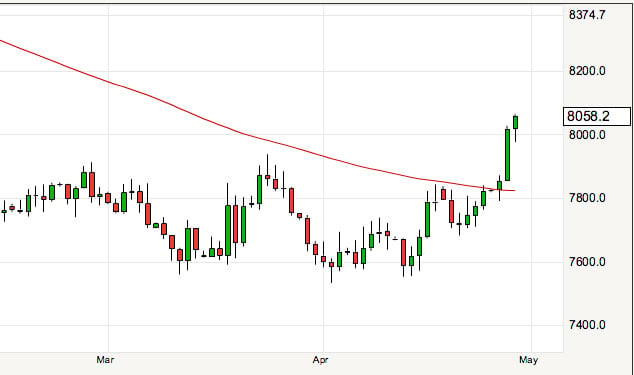Australian Dollar Grows in Confidence, More Gains Forecast
The Aus dollar has strengthened against the USD of late but forecasters suggest it would be premature to call an end to the longer-term downtrend.
Could a recovery in the Aussie’s prospects against the USD aid a recovery in the GBP-AUD?
AUDUSD broke above the technically significant 100 day moving average for the first time since September 2014.
Such an event is taken by some currency speculators as a clear sign that a corner has been turned by the Aussie.
Selling pressure has been relentless for much of 2015 and we have seen the Australian currency fall from the year's best at 0.8295 in January down to an April low of 0.7533.
At the time of writing we see AUDUSD back below the 0.800 level, but as the below suggests the currency is still ultimately at stronger levels than it has been for some time:

Above: The move above the 100 day moving average (red line) is a significant one for those betting on a higher AUD-USD.
* All currency quotes mentioned here refer to the wholesale market. Your bank will affix a discretionary spread when transferring money internationally.
However, an independent provider will seek to undercut your bank's offer, thereby delivering up to 5% more currency in some instances. Please learn more on how this is achieved here.
Can the Pound Advance?
The British pound has meanwhile tracked the fortunes of the Aussie dollar lower in a sign that suggests the fate of GBP-AUD could well rest on the performance of the AUD vs USD pair.
The pound peaked at 2.0 in February and has fallen ever since.
It would appear that any recovery in the Aussie’s prospects against the USD simultaneously favour a recovery in the GBP-AUD.
We are yet to be convinced at this stage but do not rule out such a swing in favour of sterling. The GBP exchange rate complex is seen doing well at the present time and we would expect any weakness to be limited.
At the time of writing we are seeing some strong moves higher in the pound v Australian dollar exchange rate - it appears the AUD is suffering in sympathy with the New Zealand dollar.
Australian Bond Yields Attract Currency Inflows
The recovery embarked on by AUD over recent weeks has been attributed to both a week US dollar and, importantly for the broader Aus dollar complex, a renewal in interest for buying Australian sovereign credit.
It is the high yield on Australian bonds that continues to attract investor interest, in doing so driving up demand for Australian dollars.
“The declining US, Japanese and core EZ sovereign yields fail to compete with their AU and NZ peers. Moreover, the meaningful shift in Japanese pension funds’ allocation to better yielding - yet not too risky - foreign bonds should reinforce the capital inflows into the AUD-denominated assets,” says analysts Ipek Ozkardeskaya at London Capital Group.
Will Japanese hunger for Australian yield continue to push the Australian dollar exchange rate complex ever higher?
Not necessarily argues Ozkardeskaya:
“While this carry appetite has the potential to push AUDUSD higher, the appreciation in the Aussie revives speculations for an additional RBA cut and should limit the upside.”
Indeed, technical analysts Luc Luyet of Swissquote Bank reckons the longer-term downtrend should still ultimately be favoured.
Luyet does however concede that near-term pressures are tilted in favour of the AUD:
“AUD/USD successfully tested the strong resistance at 0.8025 (29/01/2015 high), increasing
the odds of a short-term corrective phase.
“Hourly supports can be found at 0.7764 (24/04/2015 low) and 0.7683.”
But, in the long-term, there is no sign to suggest the end of the current downtrend confirms Luyet.
“Key supports stand at 0.7451 (18/05/2009 low) and 0.7000 (psychological threshold). A break of the key resistance at 0.8295 (15/01/2015 high) is needed to invalidate our long-term bearish view,” says Luyet.
Threat of a Rate Cut Recedes
The big damper on Aussie dollar strength over recent months has been the Reserve Bank of Australia’s willingness to cut interest rates.
We saw such a cut at the start of the year, but the move has not been followed by a subsequent cut.
The threat of this second cut has held back enthusiasm for the currency. If markets are confident that such a move is now firmly off the cards then we could yet see further AUD buying interest.
“The chance of another rate cut has fallen significantly in recent weeks and investors interpreted Stevens stance as a sign that the central bank will officially draw their easing cycle to a close in May,” says Kathy Lien from BK Asset Management.
Nevertheless, take consideration of those arguments that still favour the chances of a cut; ANZ Bank is one institution suggesting this could yet occur.
An uptick in economic indicators has also contributed to the rise in AUD while RBA Governor Glenn Steven's refusal to discuss monetary policy was cited by some as being the main reason why the currency performed so well at the close of April.




